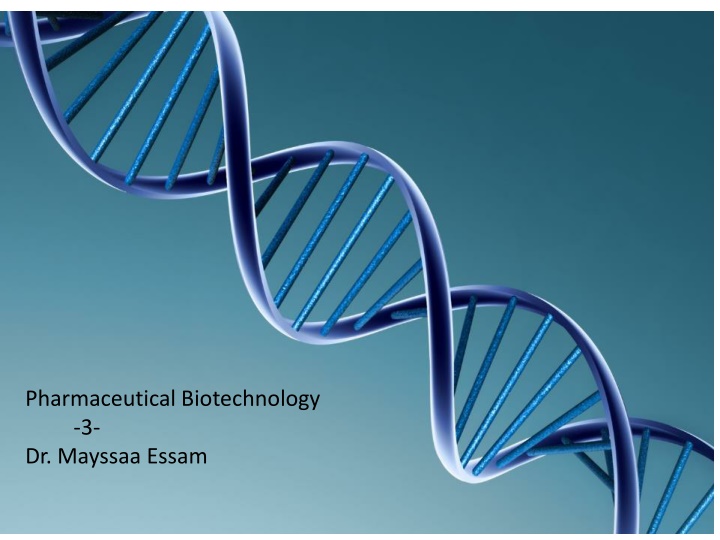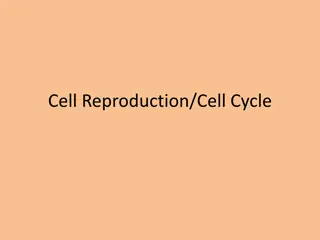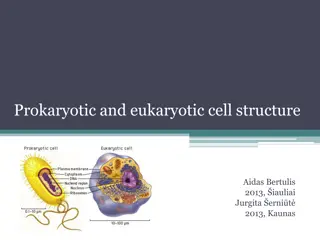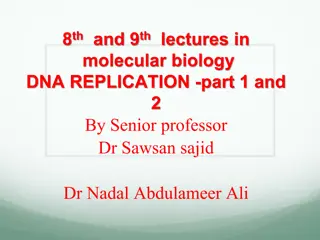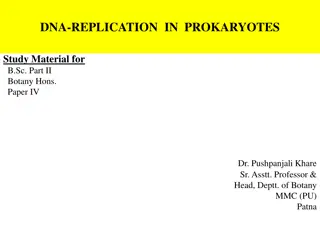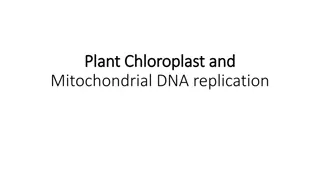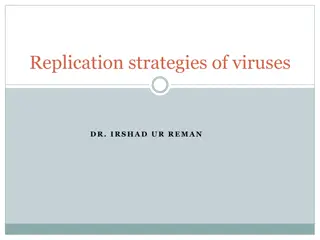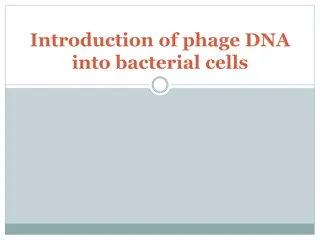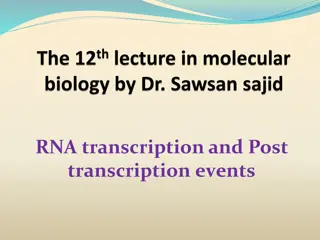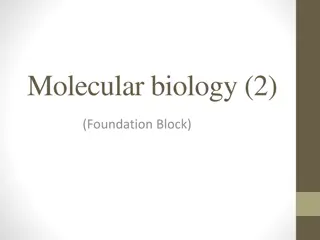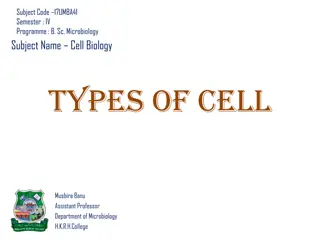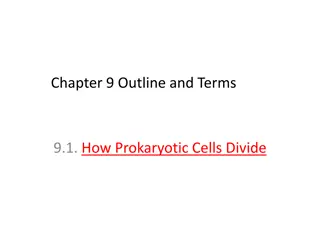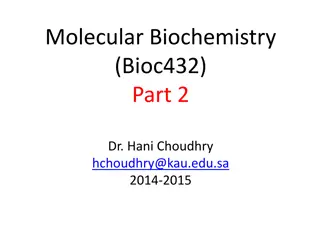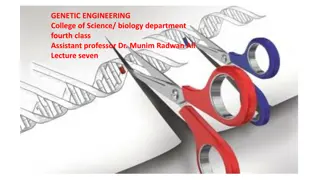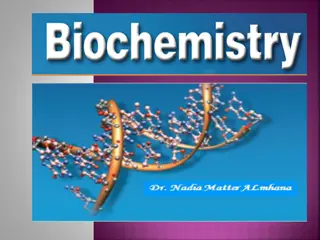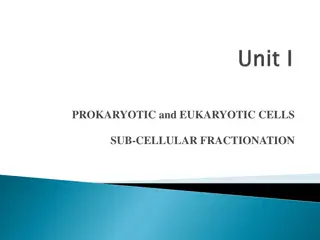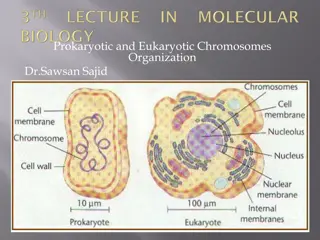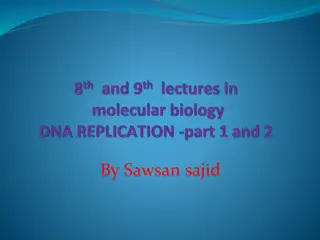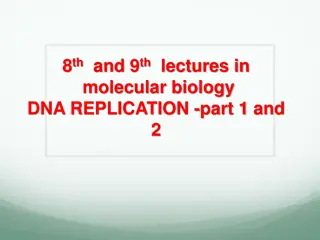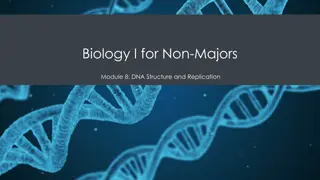DNA Replication in Prokaryotic and Eukaryotic Cells
DNA replication involves the intricate process of copying DNA in cells, ensuring accurate distribution in daughter cells. Prokaryotic and eukaryotic replication share similarities in the fundamental steps, but differ in complexities and enzymes involved. Prokaryotes replicate in the cytoplasm, while eukaryotes do so in the nucleus, with eukaryotic replication exhibiting a more intricate initiation process. Several key differences exist, such as location, timing, rate, enzymes involved, replicon characteristics, and accuracy of replication.
Download Presentation

Please find below an Image/Link to download the presentation.
The content on the website is provided AS IS for your information and personal use only. It may not be sold, licensed, or shared on other websites without obtaining consent from the author.If you encounter any issues during the download, it is possible that the publisher has removed the file from their server.
You are allowed to download the files provided on this website for personal or commercial use, subject to the condition that they are used lawfully. All files are the property of their respective owners.
The content on the website is provided AS IS for your information and personal use only. It may not be sold, licensed, or shared on other websites without obtaining consent from the author.
E N D
Presentation Transcript
Pharmaceutical Biotechnology -3- Dr. Mayssaa Essam
*DNA replication refers to the process of making a copy of DNAso that it can be distributed in two daughter cells. Replications do not occur in whole DNA. DNA is divided into some segments in which DNA replication occurs independently. The smallest unit of DNA in which independent events of replication occur is known as Replicon. Also, Replication does not initiate randomly at any point, there is some specific sequence of Nitrogen- bases where DNA gets opened, Hydrogen bonds between Nitrogen- bases break, and replication starts. This region is known as the Origin of Replication or Ori site in short. The Ori site is present in the center of replicon. After DNA gets opened, DNA replication is bi-directional which means replication occurs on both sides of the origin till the endpoints of Replicon. The endpoint of Replicon where replication stops is known as Terminus. One-half of the Replicon is known as the Replication fork. A Replicon consists of two replication forks. DNA Replication is semi-conservative because in new DNA, one strand is new and one strand is old. It is discontinuous because all DNA does not open at once, so every time DNA gets opened, a primer is to be synthesized on a lagging strand. Also, it occurs in a 5 -3 direction.DNA replication occurs in both Prokaryotes and Eukaryotes.
Replication of DNA in eukaryotic cells The essential steps of replication are the same as in prokaryotes. Starting replication is more complex in eukaryotes. At the origin of replication, a pre-replication complex is made with other initiator proteins. Other proteins are then recruited to start the replication process. The overall process is the same, although differently named enzymes fulfill the same function. The first important difference is in the polymerases. So far, 15 kinds of polymerases were isolated from the eukaryotic cells. The most important are: * DNA polymerase catalyzes the synthesis of leading strand and finishes the synthesis of lagging strand. * DNA polymerase (DNA primase) catalyzes the synthesis of Okazaki fragments. * DNA polymerase catalyzes the synthesis of short fragments during DNA reparation. * DNA polymerase catalyzes the formation of mitochondrial DNA in the mitochondria.
The impo- rtant differ ences betwe en prok aryot ic Features Prokaryotic Replication Eukaryotic Replication Location Cytoplasm Nucleus Anytime before cell division Timing S-Phase of the cell cycle Rate Faster (2000 bp/s) Slower (100 bp/s) DNA gyrase, DNA Polymerase III Helicase, Topoisomerase, DNA Polymerases , , , Enzymes Replicons One Multiple and Euka ryotic replic ation: Ori Sites One Multiple Terminus One Multiple Longer (1000-2000 Nucleotides) Shorter (100-200 Nucleotides) Okazaki Fragments Accuracy More accurate Less accurate
*Eukaryotic genomes:- Eukaryotic genomes are composed of one or more linear DNA chromosomes. The number of chromosomes varies widely , which each have only one pair, to a fern species that has 720 pairs,eukaryotic chromosome are much more complex and larger in size than prokaryotic genomes. This means that there must be multiple origins of replication on the eukaryotic chromosome in order for the entire DNA to be replicated in a timely manner; humans can have up to 100,000 origins of replication. *Do eukaryotes have a genome? *The genomes of most eukaryotes are larger and more complex than prokaryotes.This larger size of eukaryotic genomes is not inherently surprising, since one would expect to find more genes in organisms that are more complex. *How many genomes do eukaryotes have? *Two genomes, one cell. *What is the content of eukaryotic genomes? *Eukaryotic genomes are composed of both unique and repetitive DNA sequences. These latter form families of different classes that may be organized in tandem or may be dispersed within genomes with a moderate to high degree of repetiteness. * What is the function of the eukaryotic genome? *The Vast Majority of a Eukaryotic Genome Does Not Encode Functional Genes Only a small portion of the eukaryotic genome (2% 10%) constitute protein-encoding genes. There are also a large number of single-copy noncoding regions, some of which are pseudogenes.
*DNA Packaging:- The fact that certain proteins compact chromosomal DNA into the microscopic space of the eukaryotic nucleus. These proteins are called histones, and the resulting DNA-protein complex is called chromatin. It may seem paradoxical that proteins are added to DNA to make it more compact. *Eukaryotic DNA is wound around proteins known as histones to form structures called nucleosomes. The DNA must be made accessible in order for DNA replication to proceed. The chromatin (the complex between DNA and proteins) may undergo some chemical modifications, so that the DNA may be able to slide off the histones or otherwise be accessible to the enzymes of the DNA replication machinery. Prokaryotes do not package their DNA by wrapping it around histones. *why it is important of DNA packaging? *DNA packaging helps the DNA to fit well within the small size of a cell. It also facilitates the easy separation of the correct chromosomes during cell division. Due to highly packed DNA, it is easy to turn genes on or off as per requirement.
*What is the name of the packaged DNA? *In organisms called eukaryotes, DNA is found inside a special area of the cell called the nucleus. Because the cell is very small, and because organisms have many DNA molecules per cell, each DNA molecule must be tightly packaged. This packaged form of the DNA is called a chromosome. *What is the packaging of DNA presentation? *DNA is tightly packed in the nucleus of every cell. DNA wraps around special proteins called histones, which form loops of DNA called nucleosomes. These nucleosomes coil and stack together to form fibers called chromatin. Chromatin in turn forms larger loops and coils to form chromosomes.
*Gene genetic information. In meaning of molecular genetics gene is a segment of DNA codes for a protein and contain regulatory and coding parts. According to the genetic information that they carry, we can divide genes into three groups: structural genes, regulatory genes, and genes for the RNA molecules, except mRNA. A Structural Gene is a part of the DNA chain, which codes for the primary structure of the proteins. The size of the genes is expressed in the number of base pairs (bp) in the DNA, it contains. The structural gene consists of two parts: regulatory and coding part. The regulatory part is called the promoter. It contains important sequences (parts of base sequences, the so called boxes), for example TATA box, CAAT box . A gene is a basic functional and structural unit of
*In the coding areas the eukaryotic genes often contain noncoding parts (introns) in between the coding parts (exons). The coding part of the gene starts with the untranslated region (UTR) on the 5 end, which serves as a connection of the mRNA to a small ribosomal subunit. Immediately after it follows the first exon, which starts with the so called start triplet (ATG). The first exon is followed by the first intron. Then proceeds another exon etc. This area therefore contains alternating exons and introns. The last exon ends with the so called stop triplet (TAA, TAG or TGA). Then untranslated region (UTR) on the 3 end. *The regulatory gene is a part of the DNA which codes for the primary structure of the regulatory protein, which function is usually the induction or repression of the other genes expression. *The RNA coding genes are responsible for the primary structure of the ribosomal and transfer RNA and other types of smaller molecules of RNA.
*Gen Expression *Gene expression is the process by which the information encoded in a gene is turned into a function. This mostly occurs via the transcription of RNA molecules that code for proteins or non-coding RNA molecules that serve other functions. Is a novel treatment method which utilizes genes or short oligonucleotide sequences as therapeutic molecules, instead of conventional drug compounds. This technique is widely used to treat those defective genes which contribute to disease development. Gene therapy involves the introduction of one or more foreign genes into an organism to treat hereditary or acquired genetic defects. In gene therapy, DNA encoding a therapeutic protein is packaged within a "vector", which transports the DNA inside cells within the body. The disease is treated with minimal toxicity, by the expression of the inserted DNA by the cell machinery. *What is gene expression study? *Gene expression analysis is most simply described as the study of the way genes are transcribed to synthesize functional gene products functional RNA species or protein products. *Why is gene expression used? *Gene expression is important because a specific protein can be produced only when its gene is turned on. But it takes more than one step to get from gene to protein, and the process of building proteins is a key step in the gene expression pathway that can be altered in cancer.
*What are the 4 steps of gene expression? *The gene expression steps are: Transcription. mRNA processing. mRNA export. Translation. *What is the difference between DNA and RNA in gene expression? *DNA holds the genetic information or "blueprint" for the protein. RNA, specifically messenger RNA (mRNA), carries this information from DNA to the ribosomes, where translation into a protein sequence occurs. Transfer RNA (tRNA) and ribosomal RNA (rRNA) also play key roles in this process. *The process of gene expression involves two main stages: -Transcription: the production of messenger RNA (mRNA) by the enzyme RNA polymerase, and the processing of the resulting mRNA molecule. -Translation: the use of mRNA to direct protein synthesis, and the subsequent post-translational processing of the protein molecule.
*Gene therapy *Is defined as the treatment of disease by transfer of genetic material into cells. *What are the 3 types of gene therapy? *There are basically three types of gene therapy: ex vivo, in vivo, and in situ. In ex vivo gene therapy, the target cells are removed from the patient's body, engineered either by the addition of the therapeutic gene or by other genetic manipulations that allow correction of the phenotype of the disease. *What is the best example of gene therapy? *In 1990, 4-year-oldAshanthi de Silva became the first gene therapy success story. She was born with a severe combined immunodeficiency (SCID) due to lack of the enzyme adenosine deaminase (ADA). Without ADA, her T cells died off, leaving her unable to fight infections.
*Who uses gene therapy? *Gene therapy replaces a faulty gene or adds a new gene in an attempt to cure disease or improve your body's ability to fight disease. Gene therapy holds promise for treating a wide range of diseases, such as cancer, cystic fibrosis, heart disease, diabetes, hemophilia and AIDS. *Is gene therapy good or bad? *Gene therapy can be life-saving for some people with specific medical conditions, but it's expensive and can cause side effects. The development of gene therapy is highly regulated by the FDA and National Institute of Health. *What is the difference between gene therapy and gene cloning? *Take note that gene therapy is applied to treat diseases while cloning can be applied to other biotechnological techniques, depending on the need (example for agriculture) and considering as well the ethical issues. *What is the future of gene therapy? *Rather than just treating blood disorders, retinal diseases, neuromuscular and other diseases, we would eliminate them. This is the present and promise of gene therapy. But gene-based therapy opens even more possibilities, and almost unlimited potential, beyond rare genetic disorders.
*Genetic code *The set of correspondences between nucleotide pair triplets in DNA and amino acids in protein. *A group of three following bases (nucleotides) is called triplet (codon). A triplet is always read from the 5 end of the mRNA, so for example the triplet for tryptophane is: 5 U G G 3 . *There are 64 types of codons, from these only 61 code amino acids. The first, Start triplet, in mRNA is always AUG, which codes for methionine. Three of these triplets don t code for any amino acid and have an important role during the termination of synthesis of the polypeptide chain. Those are the so called termination codons or stop codons. They are: UAA, UAG and UGA. * Recombinant DNA, rDNA, is a piece of DNA artificially created in vitro which contains DNA (natural or synthetic) obtained from two or more sources.
Recombinant DNA technology A fourfold positive impact upon the production of pharmaceutically important proteins: *It overcomes the problem of source availability . *It overcomes problems of product safety . *It provides an alternative to direct extraction from inappropriate/dangerous source material. *It facilitates the generation of engineered therapeutic proteins displaying some clinical advantage.
Q: What is DNA replication? Answer: DNA replication is the process of creating two identical copies of DNA before cell division, ensuring each daughter cell receives a complete set of genetic information. Q: What are the key differences between prokaryotic and eukaryotic replication? Answer: Prokaryotic replication occurs in the cytoplasm, while eukaryotic replication takes place in the nucleus. Prokaryotic replication is faster (2000 bp/s) and more accurate than eukaryotic replication (100 bp/s). Prokaryotes have one replicon, one ori site, and one terminus, whereas eukaryotes have multiple replicons, ori sites, and termini. Q: What is the origin of replication (Ori site)? Answer: The origin of replication, or Ori site, is a specific sequence of nitrogen bases in the DNA where replication begins. It is located in the center of a replicon and it is the starting point for DNA replication. Q: How does DNA replication occur? Answer: DNA replication is a bi-directional process that proceeds from the origin of replication in both directions to the endpoints of the replicon. It is semi-conservative, meaning each new DNA molecule contains one newly synthesized strand and one original strand. Q: What are Okazaki fragments? Answer: Okazaki fragments are short DNA segments synthesized on the lagging strand during DNA replication. In prokaryotes, Okazaki fragments are longer (1000-2000 nucleotides), and eukaryotes, have shorter fragments (100-200 nucleotides).
Reference Nucleic Acids Chemistry Modifications and Conjugates for Biomedicine and Nanotechnology. Edited by: Ramon Eritja-2021
